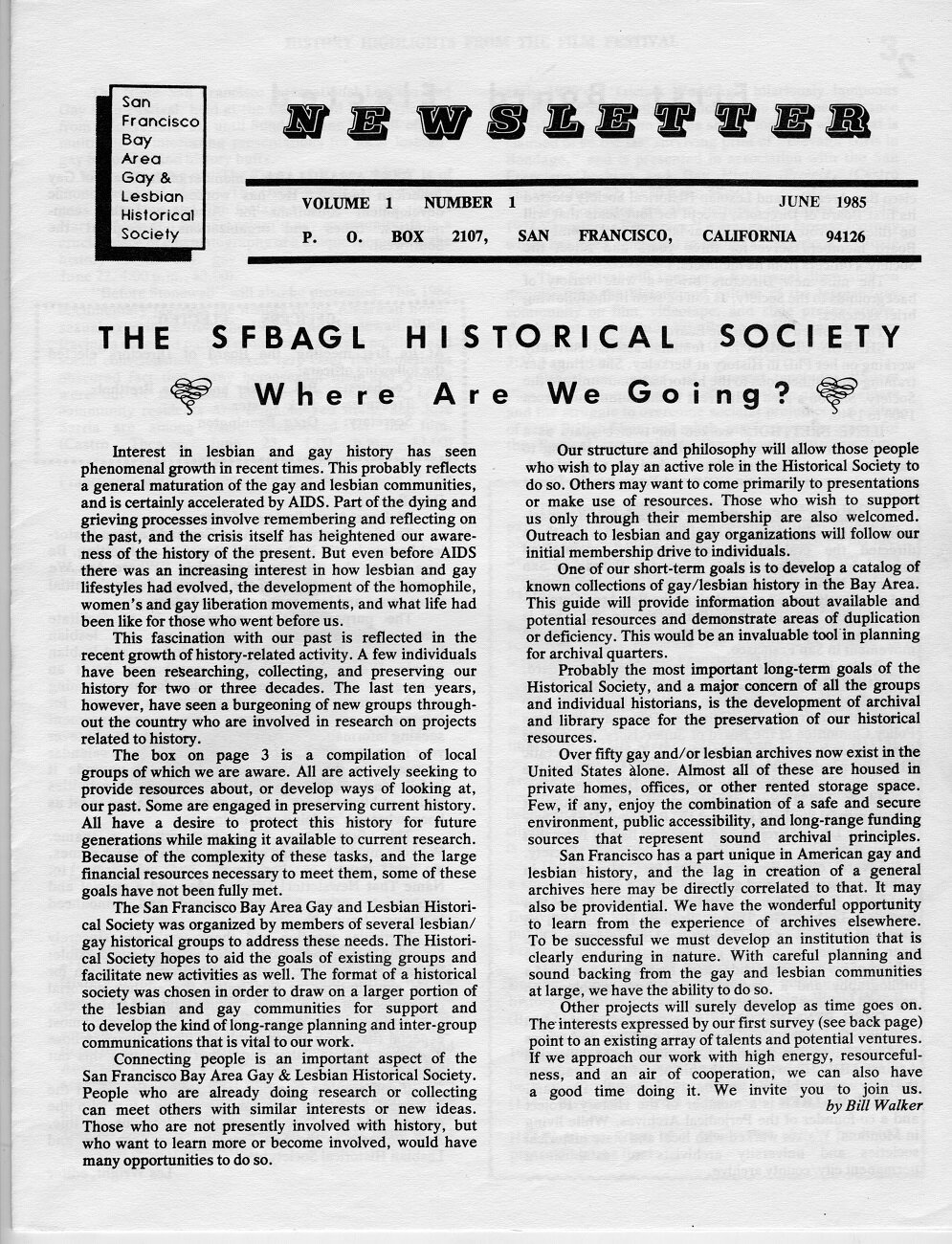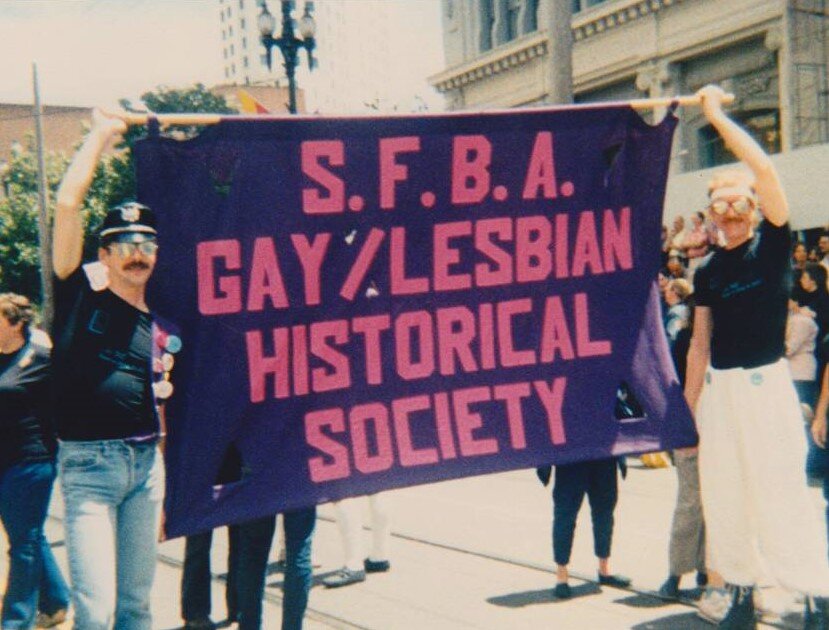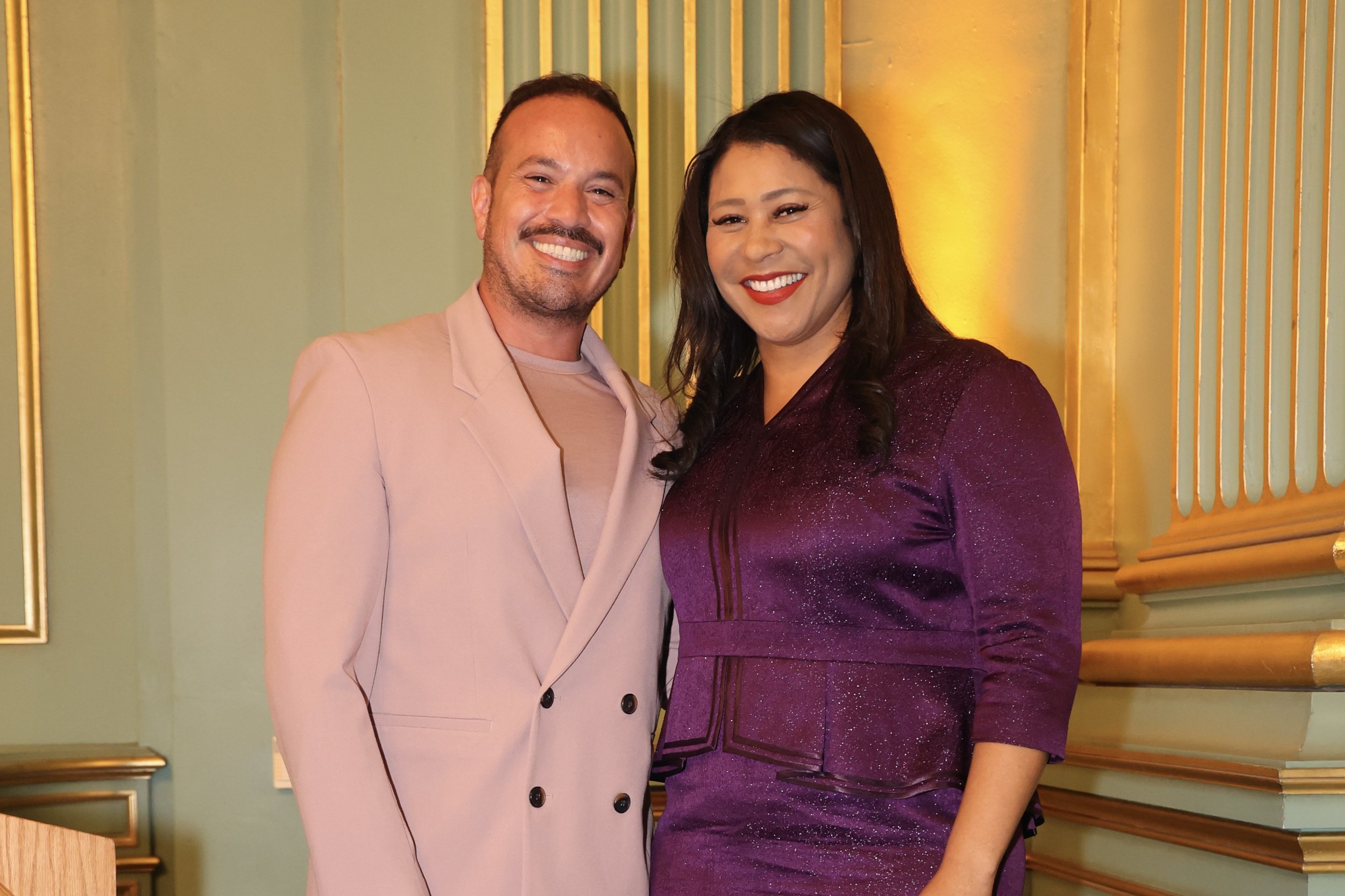our History
Since 1985, the GLBT Historical Society has been committed to preserving and sharing LGBTQ history. We have grown significantly since our founding, from a living room full of boxes to professionally managed archive. With more than 1,000 archival collections and over 26,000 museum visitors each year, the society is now an international leader in the field of LGBTQ history, and one of the most important queer cultural institutions in the world.
As we celebrate the our history, we look confidently towards the future. Support the future of LGBTQ history by making a donation today!
Volume 1 Number 1 of the society’s newsletter, published in June of 1985.
1985
On March 16, more than 60 people attend a public meeting at the old San Francisco Main Library (now the Asian Art Museum) to propose establishing an association to document and promote understanding of Bay Area queer history. The meeting, organized by Eric Garber, Jim Gordon, Terry Henderling, Ellen Klages, Greg Pennington and Willie Walker, built on smaller gatherings that had started the previous fall, and included members of the San Francisco Lesbian and Gay History Project, which had begun in the late 1970s, and the San Francisco Gay and Lesbian Periodical Archives, which had begun in 1983. On May 18, the membership votes to name the organization the San Francisco Bay Area Gay and Lesbian Historical Society and elects the first board of directors, including co-chairs Ilene Brettholz and Willie Walker (1949–2004).
1985
Members of the newly formed society march in the 1985 International Lesbian & Gay Freedom Day Parade in San Francisco.
1986
The first issue of Forward from Sha’ar Zahav, a spiritual home for LGBTQ Jews, founded in 1977. This is one of hundreds of titles contained in our vast periodicals collection.
The society quickly starts sharing its resources, by putting on its first exhibitions: displays at a reunion of the Society for Individual Rights and at the San Francisco Urban Fair.
In the same year, the society receives the holdings of the San Francisco Gay and Lesbian Periodical Archives, creating the nucleus of its Periodicals Collection.
1987
The society rents a storage locker to accommodate further accessions, having already outgrown its storage space in the living room of co-founder Willie Walker.
The society receives a trove of irreplaceable material from scholar and activist Will Roscoe, including the records of Gay American Indians, the first LGBTQ American Indian liberation organization, founded in July 1975.
In October, members carry the Gay and Lesbian Historical Society banner in the second National March on Washington for Lesbian and Gay Rights.
1989
Responding to a request from the Historical Society, San Francisco Mayor Art Agnos declares June as “Gay and Lesbian History Month” in the city.
1990
The society changes its name to the Gay and Lesbian Historical Society of Northern California to reflect a wider geographical scope for its collections, and moves into the Redstone Building on 16th Street, its first rented office space.
1991
The society accessions a major collection from Louis Sullivan (1951–1991), a pioneering gay and transgender activist and historian, a founding member of the GLBT Historical Society, and the founder of the group now known as FTM International. The collection includes correspondence, photos, essays, poems and diaries, some of which were reprinted in 2019 as We Both Laughed in Pleasure: The Selected Diaries of Lou Sullivan.
1993
The estate of Crawford Wayne Barton (1943–1993) donates an enormous collection, following the photographer’s death from AIDS. The photos in the collection offer a rare glimpse into gay life in 1970s San Francisco, and a significant number have since been digitized.
1994
The society acquires the extensive papers of activists Del Martin (1921–2008) and Phyllis Lyon (1924-2020). The collection includes the complete records of the Daughters of Bilitis, the first lesbian organization in the United States, and The Ladder, the organization’s monthly magazine. The donation is one of the many extensive archival collections held by the historical society that document decades of LGBTQ organizing and activism.
1995
The Historical Society hires its first employee – archivist Paula Jabloner – and moves to the Wilson Building at 973 Market Street, seen here. The new location provides additional space for archival collections, offices and patron services. The reading room doubles as a gallery and a space for public programs.
1996
Thirty-five years after he became the first openly gay candidate for public office, José Julio Sarria (1922–2013) donates a considerable archival collection to the society. The collection documents more than a half century of his life, including his political candidacy; his work as a founding member of the League for Civil Education, the Society for Individual Rights, and the Tavern Guild; and his role as “Her Royal Majesty, Empress of San Francisco, José I, The Widow Norton,” the persona he adopted as the founder of the Imperial Court System.
1997
The society helps to mark the centenary of the world’s first homosexual-rights organization by lending around 30 items to the monumental “Goodbye to Berlin?” exhibition mounted by the Schwules Museum at the Akademie der Künste in Berlin. This collaboration is one of dozens that have made the society’s collections available and accessible to audiences around the world.
1998
The society hires Susan Stryker, Ph.D., as its first executive director and second salaried employee. Stryker, shown here speaking at the 2017 Trans March in San Francisco, is a pioneering trans historian, whose research in the society’s archives uncovered the all-but-forgotten riot at Gene Compton’s Cafeteria in 1966.
1998
Donald Lucas (1926–2003) donates the records of the national office of the Mattachine Society, one of the earliest gay rights organizations in the United States.
1999
The society changes its name again to the Gay, Lesbian, Bisexual, Transgender Historical Society, commonly referred to as the GLBT Historical Society. The new name more clearly reflects the society’s longstanding commitment to collections and programs representing the full diversity of the LGBTQ community.
The Historical Society launches an annual series of exhibitions titled “Making a Case for Community History.” Under the guidance of exhibitions coordinator Paul Gabriel, community members curate displays during San Francisco Pride in June, from 1999-2001.
2000
Maggi Rubenstein, a longtime bisexual activist and sexologist known as the “Godmother of Sex Ed,” donates a collection covering more than a quarter century of her life. Rubenstein, who came out as bisexual in 1969, co-founded the Glide Memorial Church's National Sex Forum, the San Francisco Sex Information Hotline, the Institute for the Advanced Study of Human Sexuality, the San Francisco Bisexual Center, BI-POL and the Bay Area Bi Network.
2001
Twenty years after its first national convention, the National Association of Black and White Men Together (NABWMT) donates a significant collection of organizational history to the society. The Association is a gay multiracial, multicultural, political and social organization, founded in 1980, with more than 30 chapters around the U.S.
2002
With a grant from the National Film Preservation Foundation, the society conserves and digitizes material from the Harold T. O’Neal Collection, a collection of 8mm home movies of LGBTQ people made from 1939 to 1989.
The society receives a donation of pioneering activist Harvey Milk’s (1930–1978) personal artifacts, clothing and memorabilia that trace his life from the 1960s until his assassination. As an elected member of the San Francisco Board of Supervisors, most of Milk’s political papers are held by the San Francisco Public Library.
2003
The society moves to 657 Mission St. in the South of Market district. At the new location, the organization establishes its first dedicated galleries with an exhibition on the life and death of Harvey Milk. Photo shows the gallery space, with the suit Milk was wearing on the day of his assassination in the foreground.
2004
The society hires Terence Kissack, Ph.D., as its second executive director.
2006
The society receives the papers of social worker and theater performer Robert Coffman (1917-2005). An early member of Theatre Rhinoceros, he appeared in dozens of plays, including the landmark The A.I.D.S. Show: Artists Involved in Death and Survival in 1984 and Unfinished Business: The New A.I.D.S. Show, in 1985.
After its closure in 2005, the Filipino Task Force on AIDS (FTFA) entrusts its organizational records to the historical society. Established in 1988, FTFA was dedicated to ending the risk of HIV/AIDS in the Filipino community, offering a comprehensive range of HIV/AIDS-related services to Filipinos and Asian-Pacific Islanders in San Francisco and the surrounding Bay Area.
2007
Paul Boneberg is hired for the post of executive director, following Terence Kissack’s resignation.
2008
The society opens a pop-up museum at the corner of 18th and Castro. Open for 11 months, the museum welcomes more than 25,000 visitors from around the world. The photo at left shows guests at the museum.
2009
The society works to improve access to LGBTQ history by launching an online searchable database of the obituaries from the Bay Area Reporter, the country’s longest continuously published LGBTQ newspaper, starting with the first such article published in 1972. Many of the obituaries reflect the catastrophic toll of the AIDS epidemic in San Francisco from the early 1980s through the late 1990s.
2010
Further building its digital collections, the society begins making audio files available online, starting with recordings of more than 250 hours of content from weekly Bay Area gay radio programs produced by journalist Randy Alfred from 1973 to 1984.
2011
On January 13, the GLBT Historical Society Museum opens at 4127 18th St. in the Castro. The 1,600-square-foot space is the first stand-alone museum of LGBTQ history and culture in the United States. The front windows are seen here, shortly before the museum opened. Since it opened its doors, the museum has shared LGBTQ history with hundreds of thousands of visitors from across the globe.
2013
Adding to its holdings of early LGBTQ activism, the society receives a collection from the Society for Individual Rights (S.I.R). Founded in 1964, S.I.R. promoted a sense of queer community and provided social and legal services, including the production of the “Pocket Lawyer” to help inform people of their rights when under arrest.
In November, the society launches a project to document sites associated with LGBTQ history in San Francisco. Consultants Donna J. Graves and Shayne E. Watson direct the project. The nearly 400-page report is approved in 2015 by the San Francisco Historic Preservation Commission and is a formally recognized historic context statement.
2014
The society receives the BML Video collection, which includes more than 400 video tapes of Bay Area LGBT social and recreational events from 1977 to 2002. The collection, some of which has since been digitized, offers a rare look at contests, athletic competitions, award shows and fundraisers, parades, drag shows and more.
2016
Terry Beswick assumes the post of executive director and the society moves into a new space at 989 Market Street. The new location provides additional office space and a larger reading room and archives, seen here.
In June, the society embarks on Vision 2020, a major initiative to build a new LGBTQ museum and research center, with the goal of building capacity and completing the necessary research by 2020.
2017
The society creates the San Francisco ACT UP Oral History Project, a two-year initiative under the direction of historian Joey Plaster to chronicle, preserve and share the history of AIDS direct-action groups in the city.
The estate of Gilbert Baker (1951–2017), designer of the rainbow flag and passionate advocate for LGBTQ rights, donates a considerable archival collection to the society. The collection documents more than a half century of Baker’s political activism, artistic creations and personal life. The collection forms the basis for an exhibition, “Performance, Protest and Politics: The Art of Gilber Baker,” on display at the GLBT Historical Society museum until April 5, 2020.
2018
The society continues making its collections accessible by providing digital access. In January, it debuts an online archive of the Bay Area Reporter, a weekly LGBTQ newspaper published in San Francisco. The society also digitizes a selection of its archival holdings related to the AIDS epidemic and posts them online for researchers, in partnership with the University of California, San Francisco and the San Francisco Public Library.
Three decades after his death, the Society accessions a collection documenting the life of Sylvester (1947–1988), a famed African American genderqueer disco performer and singer-songwriter. The collection contains performance costumes, family photographs, press materials, awards, albums, and personal items.
2019
San Francisco Mayor London Breed publicly supports the society’s efforts to create the world’s first full-scale LGBTQ museum and research center. “I am excited to be here to celebrate the GLBT Museum that we are hoping will open in San Francisco because it is long overdue…We know we need a place in San Francisco. Curating and documenting LGBT history is critical to the success of San Francisco.”
2019
Ahead of schedule for the Vision 2020 campaign, the society completes a study showing that the plan to create a new LGBTQ museum and research center is not only feasible, but necessary.
In June, the GLBT Historical Society joins the Committee on LGBT History in co-hosting Queer History Conference 2019, a national conference at San Francisco State University.
2020
Mayor London Breed pledges significant financial support from the City and County of San Francisco to opening a full-scale museum of LGBTQ history and culture. With support from local and statewide elected officials, as well as broad-based interest and investment in the project, the society moves confidently into the next phase of its campaign.
2021
In April 2021, the GLBT Historical Society receives an archival donation of a fragment of one of the two monumental rainbow flags first raised on June 25, 1978 in San Francisco’s United Nations Plaza at the San Francisco Gay Freedom Day Parade.
The flag goes on display at the GLBT Historical Society Museum in June, as the museum opens after a long closure during the COVID-19 pandemic.
2022
San Francisco Mayor London Breed introduces Roberto Ordeñana, the Society’s newly appointed executive director, at our 2022 Gala, Reunion. Roberto brings more then 25 years of experience in strengthening local LGBTQ communities at the nexus of equity, economic opportunity, health, well-being and culture.
Support LGBTQ History!
Become a part of history by making your donation below. Your donation supports our efforts to preserve and share LGBTQ history for current and future generations.
Credits and Authorship
This timeline was adapted by the GLBT Historical Society from research conducted by Gerard Koskovich.
Gerard Koskovich is a San Francisco–based historian, curator and rare book dealer. A founding member of the GLBT Historical Society, he has been active in the movement to create LGBTQ archives and museums for nearly four decades and has curated numerous exhibitions on queer history and culture. Koskovich has presented and published widely in English and French, most recently with a focus on the history of queer history as a cultural practice in the United States and on LGBTQ place-based history, preservation and intangible cultural heritage. Follow him on Instagram at @gkoskovich.
Acknowledgments
Thanks to the following individuals for providing memories, documents and assistance with illustrations: Lauren Cuttler, Sasha Cuttler, Linnea Due, Paula Jabloner, Paula Lichtenberg, Ruth Mahaney, Greg Pennington, Gayle Rubin and Sharon Ullman.
Photo credits: Unless otherwise indicated, all images above are from the archival collections of the GLBT Historical Society. 1985 International Lesbian & Gay Freedom Day Parade; photograph by Sandy Morris, used with permission. Gay American Indians Flyer, 1975; Will Roscoe Papers and Gay American Indians Records (1987-04). Lou Sullivan’s diary, 1979; Louis Graydon Sullivan Papers (1991-07). Cover of The Ladder (June 1966) featuring a portrait of Ernestine Ekstein; Periodicals Collection (GLBT-PER). The exterior of 973 Market Street in 2020; photograph by Andrew Shaffer. “Elect José Julio Sarria Supervisor” campaign poster, 1961; José Sarria Papers (1996-01). Susan Stryker at Trans March San Francisco (2017); ©Pax Ahimsa Gethan (CCBY), via wikimedia. Cover of The Mattachine Review (August 1960); Periodicals Collection (GLBT-PER). BI-POL flyer, undated; Maggie Rubenstein Papers (2000-68). Photos from the 1990 Black and White Men Together Conference in San Francisco; National Association of Black and White Men Together Records (2001-21). Harvey Milk at the 1978 San Francisco Gay Freedom Day Parade; photograph by Crawford Barton, Crawford Barton Papers (1993-11). The interior of the society’s offices at 657 Mission Street in 2010; photographer unknown. The A.I.D.S. Show promotional card, 1984; Robert Coffman Papers (2006-17). Pop-up museum in 2008; photographer unknown, collection of the GLBT Historical Society. The GLBT Historical Society Museum at 4127 18th St., 2011; photograph by Gerard Koskovich, used with permission. Society for Individual Rights Pocket Lawer, ca. 1965; José Sarria Papers (1996-01). A scene from the BML Videos recording of the 1989 Folsom Street Fair, 1989; BML Videos Videotapes (2014-10). Registrar and curatorial specialist Ramón Silvestre in the archives at 989 Market Street, 2016; photograph by Ellis Martin, used with permission. Gilbert Baker holds the rainbow flag against a pink background, 1989; photograph by Robert Pruzan, Robert Pruzan Collection (1998-36). Sylvester performs at the 1980 Castro Street Fair; photo by Robert Pruzan, Robert Pruzan Collection (1998-36). Photograph by Matthew Leifheit, courtesy of the Gilbert Baker Foundation. GLBT Historical Society executive director Roberto Ordeñana and Mayor London Breed at the society’s 2022 Gala; photograph by Bradley Roberge.

























